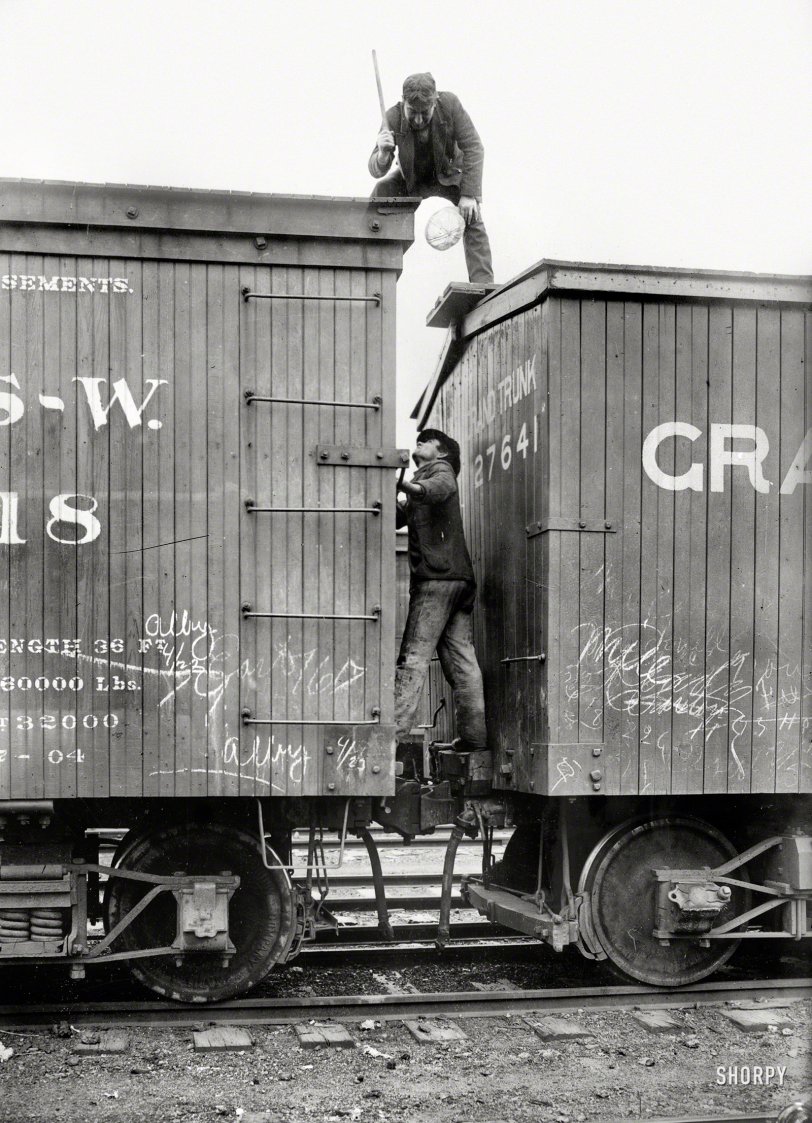


Framed or unframed, desk size to sofa size, printed by us in Arizona and Alabama since 2007. Explore now.
Shorpy is funded by you. Patreon contributors get an ad-free experience.
Learn more.

- Baldwin 62303
- Baldwin VO-1000
- Cold
- No expense spared
- Tough Guys
- Lost in Toyland
- And without gloves
- If I were a blindfolded time traveler
- Smoke Consumer Also Cooks
- Oh that stove!
- Possibly still there?
- What?!?
- $100 Reward
- Freeze Frame
- Texas Flyer wanted
- Just a Year Too Soon
- WWII -- Replacing men with women at the railroad crossing.
- Yes, Icing
- You kids drive me nuts!
- NOT An Easy Job
- I wonder
- Just add window boxes
- Icing Platform?
- Indiana Harbor Belt abides
- Freezing haze
- Corrections (for those who care)
- C&NW at Nelson
- Fallen Flags
- A dangerous job made worse
- Water Stop
Print Emporium
Hit the Grit: 1905

Circa 1905. "Tramps fighting on R.R. train -- Get down and hit the grit." Bain News Service reproduction of a Brown Bros. print. View full size.
Hit the Grit
Looks like the box car to the left is St. Louis South-Western, more familiarly known as the "Cotton Belt." The SSW used the "S-W" form in its lettering into the 1930s at least.
The car on the right is obviously Grand Trunk Ry. (of Canada). The GTR was officially absorbed into Canadian National Rys. 1923 although CN started operating it during WW1. U.S. viewers in Michigan/Indiana/Illinois will know the GTR's U.S. subsidiary, Grand Trunk Western, which has retained that name. An eastern arm of the GTR -- the U.S. portion of the Montreal/Portland ME main line -- retained the Grand Trunk name until sold off in recent years.
George Westinghouse was first allowed to install air brakes as an experiment on a Pennsylvania RR. train as early as 1869. I'd have to look up the exact date, but it was around that time. This was a short-lived "straight air" system. His automatic air brake followed because of its fail-safe feature and became federally mandated in the U.S. via the Railroad Safety Appliances Act. Again, without getting off my computer chair to look it up, I believe this was passed in the 1890s. The railroads were given a lot of time to fully install the system on their freight rolling stock -- priority was given to passenger equipment, but I believe by 1905 all cars in interchange service were so equipped. Incidentally, the same act required installation of automatic couplers. Yes, those are air brake hoses hanging down between the cars.
It's interesting to note the old-style outside brake beams. Many a hobo rode on them, sometimes to their death.
By the way, there was a hierarchy in drifter nomenclature. "Hoboes" were the cream of the crop, being the men who were riding to find work. They tended to follow the harvest cycles. Bums and tramps were the lower orders -- they had no intention of working.
Age of Photo
The box car on the left has a stencil date of 7-04 which I will assume is the construction date. The aging on the car looks to be about a year or two so C1905 is spot on IMHO. Cross referencing the car numbers to build dates would also help and I suspect that the two different designs on the Arch-bar trucks (wheel frames) would also help. Great (posed) photo!
Hobo slang
Saw some interesting words on that Hobo slang glossary - Angelina caught me off guard
--- yup, addendum, that's
--- yup, addendum, that's Yooper talk. Cheers.
[As opposed to "addemdum." - Dave]
Just a short addemdum, the
Just a short addemdum, the caption under the photo should read rail cars not train cars. Cheers.
[If you say so. ("Addemdum"?) - Dave]
Hit the Grit
Anonymous Tipster: You are correct, however, it is not a train, indeed as you noted, they are boxcars, but sitting in a yard or siding, or at best near the mainline. Also, it is certainly a posed photo. When I was a kid, in this neck of the woods, the UP of Michigan, the term for "hobo" was "bum". Bums used to write on boxcars with chalk even pencil as to where there was an easy hand-out in towns along the mainline. As we were a railroad family and lived near the tracks, we had a parade of bums knocking on our door even in the black of night. My dad always gave them a plate of grub, no strings attached. The bums would write on the nearby Milwaukee & St. Paul water tank the location of our house ---- I do appreciate the fine detail in the photo of the two wooden box cars because I remember that type was commonly still in use in my youth before the metal sides took over; I note here, myself, being a former Milwaukee Railroad employee.
Air brakes?
Did they have air brakes in 1905? To me the photo indicates a mechanism by which the brakes were applied manually. Maybe I am influenced by the stories my grandad told me about being a brakeman on UP freights, jumping from car to car to turn a wheel that set the brakes.
[The air brake was invented in 1872 by George Westinghouse. The wheel brakes are parking brakes. - Dave]
No air
The brake hoses are not connected on these boxcars, so the train must be stationary. Looks like this shot was posed, whatever it means to convey.
Jack London.
If you read Jack London's tramping book, "The Road", you will find many tales of being chased by railroad cops.
Ah yes. Reminds me of the
Ah yes. Reminds me of the movie "Emperor of the North"
Hobo slang
Here is a good online glossary of hobo slang.
























On Shorpy:
Today’s Top 5